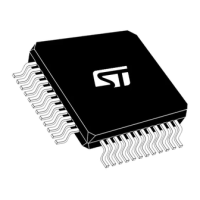DocID026079 Rev 3 19/102
STM32F038x6 Functional overview
22
3.11.5 SysTick timer
This timer is dedicated to real-time operating systems, but could also be used as a standard
down counter. It features:
• a 24-bit down counter
• autoreload capability
• maskable system interrupt generation when the counter reaches 0
• programmable clock source (HCLK or HCLK/8)
3.12 Real-time clock (RTC) and backup registers
The RTC and the five backup registers are supplied through a switch that takes power either
on V
DD
supply when present or through the V
BAT
pin. The backup registers are five 32-bit
registers used to store 20 bytes of user application data when V
DD
power is not present.
They are not reset by a system or power reset.
The RTC is an independent BCD timer/counter. Its main features are the following:
• calendar with subseconds, seconds, minutes, hours (12 or 24 format), week day, date,
month, year, in BCD (binary-coded decimal) format
• automatic correction for 28, 29 (leap year), 30, and 31 day of the month
• programmable alarm with wake up from Stop mode capability
• on-the-fly correction from 1 to 32767 RTC clock pulses. This can be used to
synchronize the RTC with a master clock
• digital calibration circuit with 1 ppm resolution, to compensate for quartz crystal
inaccuracy
• two anti-tamper detection pins with programmable filter. The MCU can be woken up
from Stop mode on tamper event detection
• timestamp feature which can be used to save the calendar content. This function can
be triggered by an event on the timestamp pin, or by a tamper event. The MCU can be
woken up from Stop mode on timestamp event detection
• reference clock detection: a more precise second source clock (50 or 60 Hz) can be
used to enhance the calendar precision
The RTC clock sources can be:
• a 32.768 kHz external crystal
• a resonator or oscillator
• the internal low-power RC oscillator (typical frequency of 40 kHz)
• the high-speed external clock divided by 32
3.13 Inter-integrated circuit interface (I
2
C)
The I
2
C interface (I2C1) can operate in multimaster or slave modes. It can support Standard
mode (up to 100 kbit/s), Fast mode (up to 400 kbit/s) and Fast Mode Plus (up to 1 Mbit/s)
with extra output drive.
It supports 7-bit and 10-bit addressing modes, multiple 7-bit slave addresses (two
addresses, one with configurable mask). It also includes programmable analog and digital
noise filters.

